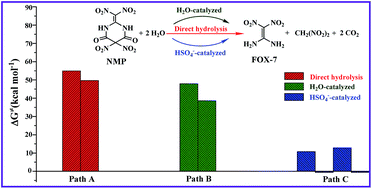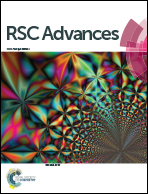Impact of the acidic group on the hydrolysis of 2-dinitromethylene-5,5-dinitropyrimidine-4,6-dione†
Abstract
The hydrolysis mechanism and the kinetics of using 2-dinitromethylene-5,5-dinitropyrimidine-4,6-dione (NMP) to prepare the representative insensitive energetic material 1,1-diamino-2,2-dinitroethylene (FOX-7) in a nitric–sulfuric acid system are systematically investigated via a density functional theory (DFT) method. The impact of the co-existing acidic group of HSO4− as well as the solvent effects of the mixed acids on the hydrolysis of NMP are elucidated and discerned, and the proposed catalysis and promotion of the hydrolysis of NMP with HSO4− are verified. The HSO4−-catalyzed hydrolysis pathway is more favorable than the direct pathway as well as the H2O-catalyzed hydrolysis, indicating that HSO4− may be a promising catalyst for the preparation of FOX-7 in a mixed acid system. The present study is expected to provide a better understanding of the hydrolysis of NMP, and will significantly help with better preparation of FOX-7 and other nitro-energetic materials.



 Please wait while we load your content...
Please wait while we load your content...